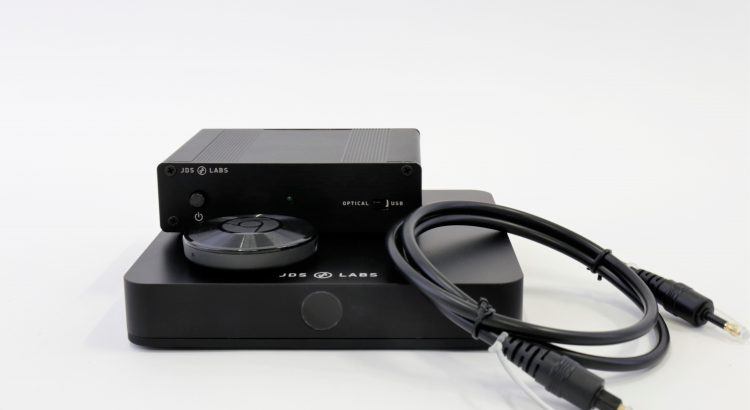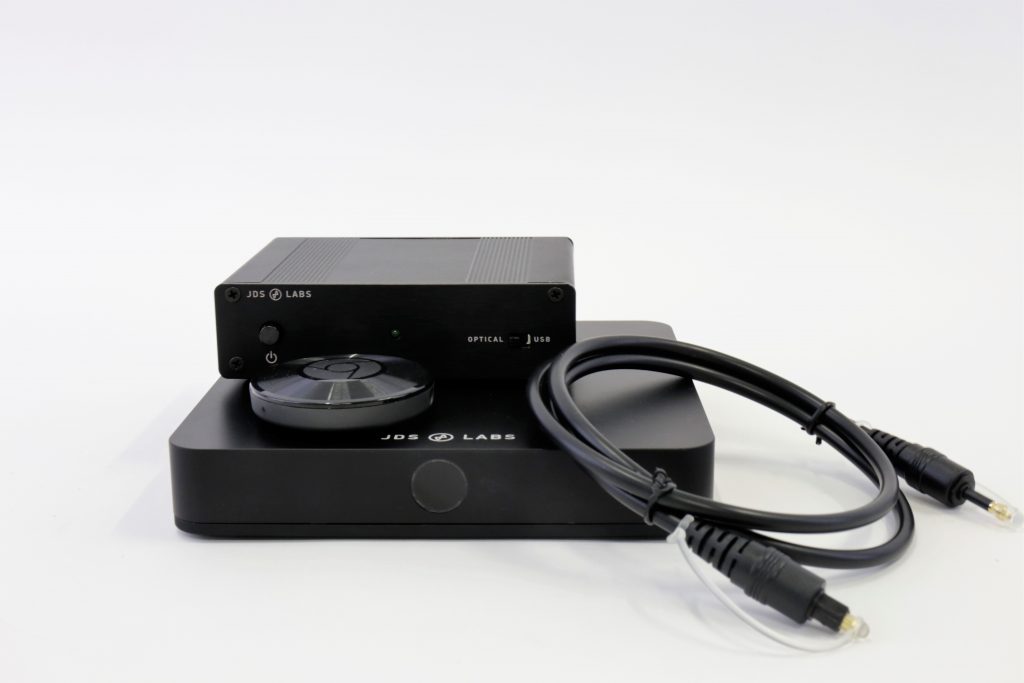Pairing Google’s Chromecast with a DAC
During development of the JDS Labs OL & EL DACs, we went a little optical crazy around the office. You can see the results of some of these experiments in this post from last year.
We received an email late last year from Erik, who mentioned that he uses his OL DAC with Google’s Chromecast Audio, an optical source that we had overlooked. That began our Chromecast Audio + DAC journey and we’ve never looked back. We highly recommend this combination if you’re looking into building a hi-res streaming system.
Chromecast Audio connects to any optical DAC to stream high quality audio over WiFi to any audio system, usually a set of powered speakers or larger stereo, and can be used with apps from smartphones, tablets, and PCs.
Why Chromecast?
We like the Chromecast Audio for many reasons, namely: value, audio quality, and app selection. It works seamlessly with the JDS Labs OL DAC and EL DAC to form a strong base for any listening setup.
The device itself is only $35, leaving tons of room in even the most modest streaming budget. Pair it with a google home mini ($49) and additional Chromecasts for a voice-operated budget multi-room streaming setup. Utilizing digital optical out at 24-bit/96kHz, pairing the Chromecast Audio with the OL DAC and any headphone/speaker system will give you a fantastic high-res listening station. The Chromecast Audio is also compatible with a vast number of apps and operating systems. Stream Tidal, Google Play Music, Deezer, Spotify, NPR One, Pocket Casts, 8Tracks, and more through Mac, Windows, Android, or iOS.


There are only two problems with the Chromecast Audio as a network audio source:
1) The TOSLINK output is jittery (look up Archimago’s measurements)
2) No support for gapless audio
Still, it’s great, and even if you just use it as a DAC, it’s surprisingly capable. I do recommend using it with BubbleUPnP on Android for best results if you have a music server in you network.
Hm, is this the set of measurements you’re referring to? To quote the author,
Looking at the 24-bit J-test, this is a solid conclusion.
That’s for the analog portion, this is for the digital output specifically where the measurement is more apparent, but yeah…probably not a serious issue. http://archimago.blogspot.com/2016/02/measurements-google-chromecast-audio_27.html (though the lack of gapless playback is still annoying!)
I will also note that if you have an Android device, make sure you get BubbleUPnP, it expands what your Chromecast can do, especially if you want to play music back from your local network on one.
The folks at Roon now support the Chromecast Audio (which is still available in huge quantities for regular retail prices in Australia for some reason) and have managed to get it to support gapless playback ftw!
I use a Chromecast Audio as an optical input for my current setup. It’s wonderful. I have this fantasy of an integrated DAC/Amp solution featuring the Atom amp with Bluetooth and/or Chromecast Audio type support.
Now that Chromecast Audio (CCA) is discontinued, can a Chromecast be used with an HDMI audio extractor to stream hi res audio?
I’m not 100% sure on that! From a quick search, it looks like there’s some pockets of people using this solution with mixed results; I have yet to test this myself.
“Utilizing digital optical out at 24-bit/94kHz”….. wouldn’t the information be outputted at 24/192 once it goes through the OL DAC via optical ?
Typo! Should read 24/96k. Thanks!
why not 24/192 ? …. isn’t the digital info bypassing CCA dac and going to OL DAC at 24/192 ?
Alternatives to Google Chromecast audio?
Still a gap in the market, as far as I know!
This is sad. My CCA devices are still going strong. I suppose as long as the ChromeCast protocol is supported the devices will continue to work. It’s hard to beat as an optical source from a price performance perspective.
The only similar product I found is the Amazon Echo Input. It’s pretty close. No digital port though.
No digital port means no comparison. You can’t compare standard 320kbs streaming to Ultra HD audio using a DAC.
I’m relatively new to the audio game, just wondering if this would work. I have a vintage amp and speakers hooked up to my turntable. The amp does not a built-in DAC or a digital in. I have got ahold of a Chromecast audio, so if I purchase the optical Ol DAC, I should be able to run the 3.5mm cable from the CCA into the DAC and then run an RCA cable into my amp and get streaming music into my system?
Any help is much appreciated.
Liam. What you described will work. You can also use a 3.5mm to RCA and connect the CCA that way while you wait for your OL DAC to arrive.
How much better is the sound quality running the CCA optical to external DAC rather than using the 3.5mm with the CCA internal DAC? I have a CCA but only use the 3.5mm and am wondering whether to purchase a separate DAC. Cheers!
Certainly optical offers better signal – I’ve used this route for two headphone amp stations (JDS dac and amp and a Schiit stack) with good results (convenience and audio fidelity), as well as through the JDS Lans Ol Dac with optical in (ads some cost over USB base version) and then rca out to a Harman Kardon (rca in only) receiver driving Focal Bookshelf Speakers and monolith powered sub (and hi-res Spotify and Tidal as streaming source off iPhones. The external dacs will generally open up sound stage and instrumental detail/separation. Additionally, Tidal a/b against audiophile CD player (marantz) into same set up produces negligible difference to my ears in a 12×20 listening room at comfortable listening levels. CCAs can still be found on eBay, but increasingly at more than original list and from Canada or AU, in which case you will have to sub a US/USB power adapter if you are elsewhere. Happy listening. Google missed the boat when they discontinued this product, as they failed to factor in the music community with legacy systems not interested in upgrading to new receivers with HDMI (for the current Chromecast) or other streaming capability.
When it comes to HiFi audio quality, Tidal should be the choice. And I just got a tip of Tidal which maybe helpful for Tidal users. It can help you to listen to Tidal music offline by using the DRmare Tidal to MP3 Converter. And then you can easily use Tidal music on portable devices as you like.
I do understand the benefit from streaming audio content with Google Chrome cast Audio.
Unfortunately I have never come across with playing own content, which for example saved at a pc. I have very good quality DSD content from friends which I have saved on my external HDD, transferred to my smart phone, and the listening enjoyment is unbelievable with the Chrome cast audio, as well with my (High End) sound system inside the house as outside with just an ordinary preamp/poweramp and speakers. I would like to know about the experiences from other forum members with their own audio content please?
I sincerely do hope to get some response on my question from other forum members please!
I love to use Chromecast to stream Tidal music and playlists to other devices for playback. And I have followed this page: https://www.audfree.com/tidal/stream-tidal-to-chromecast.html to do it well. It covers two ways to stream Tidal on Chromecast via the Google Cast or AudFree Tidal Music Converter. Love Tidal, love Chromecast.
Thank you very much for sharing the interesting link. I do have 2 Google audio Chromecast dongles, but I’ve noticed you are talking about the HDMI Chromecast dongles, which is nice to use as a streaming device. Actually I just stream audio content from the Apple music app (AAC) via my Android smart phone, but I’m also interested to play audio content which I saved on my “micro SD card”. It all sounds fabulous via Google Chromecast Audio especial with the “dynamic” feature on.
Hey guys, forgive my ignorance but can someone explain how to connect CCA to a DAC?
@Edward – Plug the CCA into your phone, then plug the DAC into the CCA using its USB cable.
You use a Mini-Toslink Optical cable. One side is the 3.5mm mini-optical jack that would exit from your CCA and the other would be the standard TOSLINK optical end that would enter into your DAC.
Here are two examples of just such a cable from the cheapest up….
https://www.monoprice.com/product?p_id=1557
http://www.lifatec.com/toslink2.html (Toslink to Miniplug version)
I prefer to listen to music on Tidal, and also use TunesKit Audio Capture to stream Tidal to Chromecast. With this tool, I am able to download music from Tidal and make it playable on any device I like.